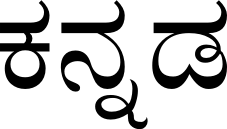Difference between revisions of "Language/Kannada/Grammar/Conjuncts"
m (Quick edit) |
m (Quick edit) |
||
| Line 1: | Line 1: | ||
{{Kannada-Page-Top}} | {{Kannada-Page-Top}} | ||
<div class="pg_page_title">Kannada Grammar → Conjuncts</div> | <div class="pg_page_title">Kannada Grammar → Conjuncts</div> | ||
| Line 10: | Line 8: | ||
As a Kannada language teacher for over 20 years, I believe that learning about conjuncts is essential to become proficient in this beautiful language. In this lesson, we will explore everything you need to know about Kannada conjuncts, their pronunciation, and how to write them. | As a Kannada language teacher for over 20 years, I believe that learning about conjuncts is essential to become proficient in this beautiful language. In this lesson, we will explore everything you need to know about Kannada conjuncts, their pronunciation, and how to write them. | ||
<span link>Take some time to dive into these other pages after completing this lesson: [[Language/Kannada/Grammar/Questions|Questions]] & [[Language/Kannada/Grammar/0-to-A1-Course|0 to A1 Course]].</span> | |||
== What are Conjuncts in Kannada? == | == What are Conjuncts in Kannada? == | ||
| Line 66: | Line 66: | ||
[[Category:Kannada-0-to-A1-Course]] | [[Category:Kannada-0-to-A1-Course]] | ||
<span gpt></span> <span model=gpt-3.5-turbo></span> <span temperature=1></span> | <span gpt></span> <span model=gpt-3.5-turbo></span> <span temperature=1></span> | ||
==Videos== | ==Videos== | ||
| Line 81: | Line 78: | ||
<youtube>https://www.youtube.com/watch?v=a4ixidyTejE</youtube> | <youtube>https://www.youtube.com/watch?v=a4ixidyTejE</youtube> | ||
==Other Lessons== | |||
== | |||
* [[Language/Kannada/Grammar/Pronouns|Pronouns]] | * [[Language/Kannada/Grammar/Pronouns|Pronouns]] | ||
* [[Language/Kannada/Grammar/Prepositions|Prepositions]] | * [[Language/Kannada/Grammar/Prepositions|Prepositions]] | ||
| Line 92: | Line 88: | ||
* [[Language/Kannada/Grammar/Gender|Gender]] | * [[Language/Kannada/Grammar/Gender|Gender]] | ||
* [[Language/Kannada/Grammar/Past-Tense|Past Tense]] | * [[Language/Kannada/Grammar/Past-Tense|Past Tense]] | ||
<span class='maj'></span> | <span class='maj'></span> | ||
| Line 100: | Line 95: | ||
{{Kannada-Page-Bottom}} | {{Kannada-Page-Bottom}} | ||
<span links></span> | |||
Revision as of 23:13, 27 March 2023
As a Kannada language teacher for over 20 years, I believe that learning about conjuncts is essential to become proficient in this beautiful language. In this lesson, we will explore everything you need to know about Kannada conjuncts, their pronunciation, and how to write them.
Take some time to dive into these other pages after completing this lesson: Questions & 0 to A1 Course.
What are Conjuncts in Kannada?
Kannada is a language that uses characters that are combined to form conjuncts. These conjuncts are formed using half or full characters by removing the space between the letters. The combination of these letters forms a new character with a unique pronunciation.
In Kannada, there are three types of conjuncts:
- Gunitakshara
- Yuktakshara
- ಒಂದು ಅಕ್ಷರ (One letter word)
Gunitakshara is formed by combining two or more full characters, while Yuktakshara is created by combining a full and a half character.
Pronunciation Rules for Conjuncts
Here are some general rules for pronouncing Kannada Conjuncts:
- The first letter of the conjugate is pronounced fully.
- The second letter is pronounced in a half-form.
- If the conjunct starts with 'y', it is pronounced fully.
- If the first letter of the conjunct ends with a vertical line or a curve, the second letter's half-form has a tail.
Let's look at some examples:
| Kannada | Pronunciation | English |
|---|---|---|
| ಮುದ್ದು | muddu | Kissing |
| ದೂರು | dooru | To leave |
| ಶಾರ್ಟ್ | shaartu | Shirt |
How to Write Conjuncts
Writing Kannada conjuncts can be tricky, but it is essential to learn if you want to read and write in Kannada. Here are some tips to keep in mind when writing a Kannada Conjunct:
- First, write the full character of the first letter.
- Next, add the half-character of the second letter that follows the full letter. Make sure that the half-letter forms a perfect right angle with the full letter.
- You can further add other half or full character letters to form a complete word or sentence.
Be sure to practice your writing skills regularly to become proficient in writing Kannada conjuncts.
I hope this lesson has given you a good foundation in understanding Kannada Conjuncts. Keep practicing, and you'll be able to read and write like a pro in no time!
Videos
Conjunction | Parts of Speech | Learn English grammar in Kannada
Parts of Speech Part 7 - Conjunctions(Part-1) | Explained in Kannada
Kannada Conjunctions Tutorial - YouTube
Other Lessons
- Pronouns
- Prepositions
- Conditional Mood
- How to Use Have
- Vowels
- Conjunctions
- Negation
- Gender
- Past Tense
Sources
